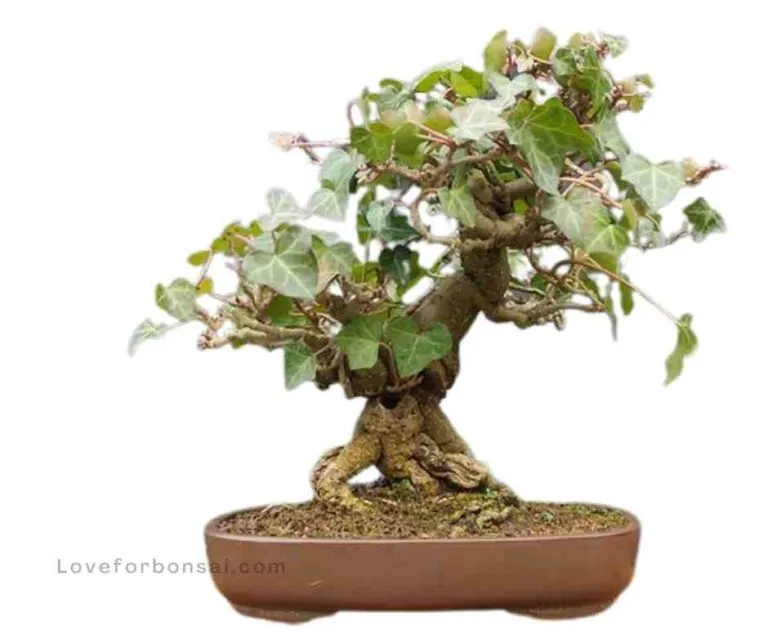How to care for your ivy bonsai (Hedera helix) like a pro! Keep your ivy bonsai thriving with these easy tips!
If you have an ivy bonsai, you are in for a treat. Ivy is a beautiful and versatile plant that can be shaped into many different shapes and forms.
However, like any other plant, it requires care in order to stay healthy and vibrant. You can make hedera helix or ivy bonsai but it’s not as easy as making a juniper or other conifer bonsai. The good news is that with a little practice it’s not too difficult either.
So, to help you guys, in this article, we will discuss the basics of how to take care of your ivy bonsai and help you keep it thriving.
A little bit about Ivy Trees :
The popularity of vine plants as bonsai specimens has been on the rise in recent years. While there are many types of vines that can be used for this purpose, one of the most popular choices is Ivy or Hedera helix, also known as English ivy.
Hedera helix, also commonly known as ivy, is a vine belonging to the Hedera genus. They have been used for centuries as ornamental plants and have a wide variety of applications. You can grow Ivy as a bonsai tree by training it to grow in a small pot.
Ivy is a hardy plant that can thrive in a variety of climates, making it a good choice for bonsai enthusiasts who live in colder regions. The attractive foliage can add visual interest to any bonsai arrangement.

Ideal position:
When it comes to ivy bonsai, the options for where to keep them are many. Partial shade is a good option, as is keeping them near a window where they can get some light. Interestingly they can also grow in shaded conditions.
Lighting:
Full sunlight is not necessary for growing English Ivy bonsai. Ideally, they prefer partial shade. If you live in temperate climates you can grow Ivy bonsai in full sun as long as the humidity is high.
Temperature:
Ivy bonsais prefer cool temperatures, between 50 and 70 degrees Fahrenheit. They can handle warmer temperatures for short periods of time, but they will not thrive in hot weather.
You can place your ivy bonsai outdoors during the summer as long as the temperature is below 85 degrees Fahrenheit.
Watering:
Like all plants, ivy bonsai trees need water to survive. However, how much and how often to water an ivy bonsai tree depends on a number of factors, including the time of year, the pot size, and the type of soil.
In general, ivy bonsai trees should be watered regularly, especially during times of high heat and humidity. You can reduce the amount of water during winters.
Feeding:
Fertilizing your ivy bonsai is important if you want it to stay healthy and look its best. Feed your ivy bonsai every fortnight using a balanced liquid fertilizer.
Pruning and Styling:
Ivy bonsai can be pruned in a variety of ways to create different shapes and styles. One of the most important things to remember when pruning ivy bonsai is to keep the central trunk strong.
There are several ways to prune ivy bonsai. The most common method is to trim the branches back to where they meet the central trunk. You can also trim off the branches entirely, or create a more natural look by leaving some branches longer than others.
Prune your ivy bonsai repeatedly in the growing season. This will help you create a thick trunk faster. With maturity, they tend to prove more “woody” and tree-like.
Remember it takes time (sometimes decades) to create a well tapered tree trunk.
Experiment with different styles and find what works best for you and your ivy bonsai. You can create almost any bonsai style from your Hedera plants, except maybe formal upright.
Propagation:
The Ivy plant is mostly propagated through cuttings. Although you can grow ivy bonsai from both young and mature trees, always prefer a cutting from a matured ivy.
Cuttings taken from shrubby plants retain the same characteristics of the mature tree and so are suitable for bonsai styling.
Repotting:
Ivy is a versatile plant that can be used for bonsai, and it’s easy to care for. It can be repotted any time of the year, but spring is the best time because new growth will be starting.
When repotting, use standard bonsai soil.
When repotting, be sure to remove as much of the old soil as possible and loosen the roots. If the plant is rootbound, cut some of the larger roots before repotting.
After replanting, water thoroughly and keep the soil moist.
Pests and diseases:
Pests and diseases are common problems for ivy bonsai and you will commonly find red spider mites, scale insects, and aphids affecting your bonsai tree.
These pests can cause leaves to yellow and fall off, and they can also damage the branches of the tree.
Leafspot are another common problem for ivy bonsai. The disease causes brown spots on the leaves.
Conclusion:
In conclusion, if you want to take care of your ivy bonsai like a pro, make sure to water it regularly, fertilize it every few months, and trim it regularly. With these easy tips, your ivy bonsai will be thriving in no time!
I hope this post was helpful to you. Don’t forget to share it with others too.